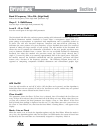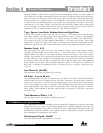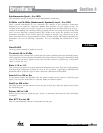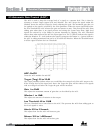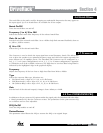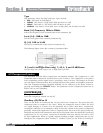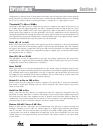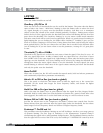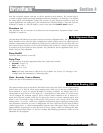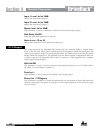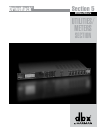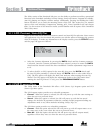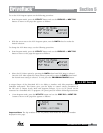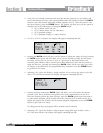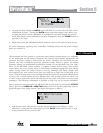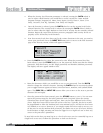
DriveRack
®
37
DriveRack® User Manual
than the overshoot amount, and that it will not introduce harsh artifacts. The second stage is
a unique program limiter featuring Intelligent Predictive Limiting™. Its function is to monitor
the input signal and intelligently predict the amount of gain reduction needed to keep the
output signal below the ceiling set by the Instantaneous Transient Clamp™. Note that since the
PeakStop+™ limiter is a fail-safe limiter, it must come after the OUTPUT GAIN control.
Overshoot 1-6
This parameter sets the amount of overshoot for the Instantaneous Transient Clamp™ when
PeakStop+ is turned on.
4.10 Alignment Delay
The DriveRack 260 offers pre-crosssover and post-crossover alignment delay. The post-crossover
Delay modules can be used for delay compensation when speaker drivers are offset from one
another, compensation for the difference in high and low frequency speed, and delay fills. The
pre-crossover Delay modules can be used for delaying the system as a whole, without having
to readjust each post-crossover delay module. The parameters for the alignment delay are as
follows and are user adjustable:
Delay On/Off
Turns the Delay module on and off.
Delay Time
Sets the amount of speaker alignment delay time. Delay times include:
• Seconds - 0.00 to 1.3
• Feet - 0 to 1465.1
• Meters - 0 to 445.9
Note: The delay time must be allocated to be available. See section 3.5 ‘Creating a User
Configuration’ for information on allocating delay.
Units - Seconds, Feet or Meters
Selects the unit of measurement for the delay.
4.11 Input Routing (IN)
The signal routing begins at the INPUT ROUTING block of the 260. There are two input routing
mixers; they are ‘A’ and ‘B’. These input routing mixers allow you to mix any combination of
input channels, 1 and 2, for greater flexibility in routing. Generally, by default, input Ch. 1
corresponds to input mixer ‘A’ and input Ch. 2 corresponds to input mixer ‘B’, however this
can be changed. For example, inputs 1 and 2 could be mono summed to the ‘A’ mixer for a
mono front of house system, while the ‘B’ mixer also receives a mono summed signal, from
inputs 1 and 2, but feeds a delay or balcony fill. The power in such a setup is that each input
routing mixer, ‘A’ and ‘B’, could have completely independent input signal processing chains
and parameters. Therefore, in such a configuration, the user could Auto EQ the front of house
system (input mixer ‘A’ chain) independently from the delay fills (input mixer ‘B chain) and
apply feedback suppression to only the front of house system, while not affecting the delay
fills. Each input routing mixer (‘A’ and ‘B’) contains the following parameters, which are user
adjustable on all programs.
Section 4
Detailed Parameters



